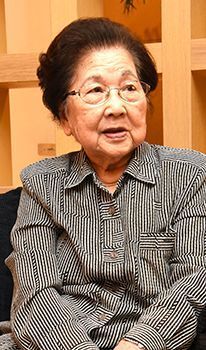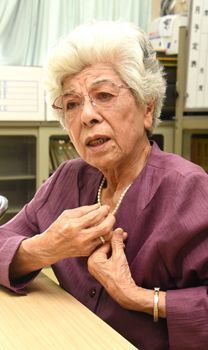Battle of Okinawa survivors speak of mixed feelings about the emperor system, memories of war, and the emperor’s visits to Okinawa (Heisei and Okinawa)

Kiku Nakayama says that meeting with the emperor and empress caused her resentment to melt away; on April 25, in Naha
April 28, 2019 Ryukyu Shimpo
By Yoshinori Takada
On April 30, the emperor will abdicate, marking the end of the Heisei era. The emperor has visited Okinawa eleven times from the time he was crown prince to the present. Both the emperor and empress have visited Okinawa, the only place in Japan to experience a land battle during the war and where a huge number of civilians suffered in the battle, to pay their respects to the lives lost. Some hold the Showa emperor responsible for the war; meanwhile, the Heisei emperor has endeavored to be a friend to Okinawa. As we approach the start of the Reiwa era, survivors of the war have distinct feelings towards the emperor system and the imperial family.
– Former Shiraume Student Nurse Corps member Kiku Nakayama says her resentment has melted away
The emperor and empress slowly rose from their seats. They turned partway around and bowed their heads deeply. They were facing in the direction of the Shiraume Memorial Tower.
In November 2012, the emperor and empress were in Okinawa for the 32nd Nationwide Event for Creating Bountiful Oceans. Kiku Nakayama, 90, of Naha, who was mobilized during the Battle of Okinawa as a member of the Shiraume Student Nurse Corps from the Okinawa Prefectural Daini Girls High School, met with the emperor and empress at the Okinawa Peace Hall in Itoman.
Nakayama sat across a table from the emperor and empress in a small room. She says she explained to them how there were nine female student corps in Okinawa, and how she speaks about her experience so that war will never be repeated; they responded with deep nods and comments of, “What a harrowing experience,” and, “That is very important.”
Once the allotted ten minutes were up, Empress Michiko asked the direction of the Shiraume Memorial Tower. Nakayama told her the direction, and both emperor and empress rose from their seats.
Nakayama was born on the enthronement day the Showa emperor, and was given the name Kiku, written with the Chinese character meaning chrysanthemum–a symbol of the imperial throne. She despised her father, whose illness prevented him from joining the military, and joined the student corps of her own accord. Nonetheless, after the war she was unable to shed the sense that Okinawa was sacrificed in order to protect the emperor system. That was why, when she got a new household register to replace the one that was lost in fire, instead of using the character for chrysanthemum to write her name, she wrote it as “Kiku” in the hiragana syllabary.
The emperor visited Okinawa 11 times. “When I met him, I understood that he really has a place in his heart for Okinawa. My resentment melted away,” Nakayama recalls.
– Keiko Taira, survivor of the Tsushima-maru sinking, recalls the faces of the children who died
Some people still feel negatively about the imperial household. Keiko Taira, 84, of Ogimi, is a survivor of the Tsushima-maru, a ship carrying student evacuees that was sunk during the war. In June 2014, 70 years after the Tsushima-maru was sunk by a torpedo from a U.S. naval submarine in August 1944, the emperor and empress visited the Tsushima-maru Memorial Museum in Naha. Taira was notified of their visit in advance by museum staffers, but she chose not to meet them.

Keiko Taira says that when she thinks of the children who perished, she is unable to accept the emperor system; on April 26, in Ogimi
Roughly 1,500 children died on the ship. “The boys dreamed of becoming kamikaze pilots or soldiers to protect the emperor. The girls dreamed of becoming nurses for the troops,” Taira says. The children were taught to devote themselves to their country and to the emperor. Taira’s memories of the national elementary school involve more evacuation drills and martial arts training than schoolwork. At the school gate when arriving and leaving the school, and in the classroom, the students were made to perform a deep bow of obeisance many times a day. Eight seconds to put their heads down, and eight seconds to raise them back up.
After making it out of the sinking alive, Taira also experienced the Battle of Okinawa. She feels not that her life was spared, but that she pulled through. “The fighting was constant,” she says. “At sea and after I came back to Okinawa, it was impossible to survive without sacrificing someone else’s life.” The faces of the children who lived and died for the emperor arose in her mind, and she decided not to meet the emperor.
Taira knows that the emperor paid his respects at war sites and disaster-stricken areas. “I don’t dislike the emperor as a person. But it was because of the emperor system that Japan plowed into the war. I don’t regret not going to meet the emperor,” she says with a piercing look.
(English translation by T&CT and Sandi Aritza)
Previous Article:Three US students win Okinawa Essay Contest
Next Article:Okinawa prefectural museum starts an exhibition displaying 250 new items
[Similar Articles]
- Tsushima-Maru survivor delivers lecture to elementary school pupils
- “Try to imagine”–Okinawa Shogaku students teach Hiroshima high school students about the Battle of Okinawa, show them the footsteps of the Shiraume students
- Tsushima Maru Memorial Unveiled in Uken
- Memorial service held for victims of Tsushima-Maru tragedy
- Emperor and Empress enjoy Okinawa karate demonstration on their last official visit to Okinawa
 Webcam(Kokusai Street)
Webcam(Kokusai Street)


